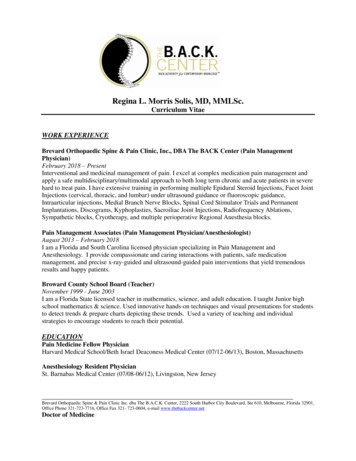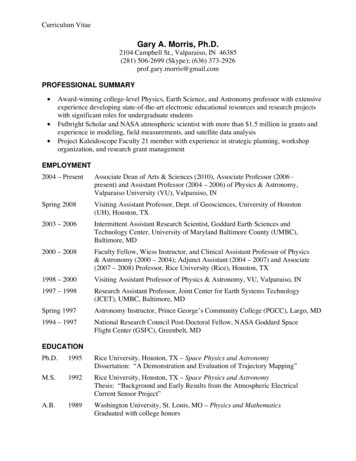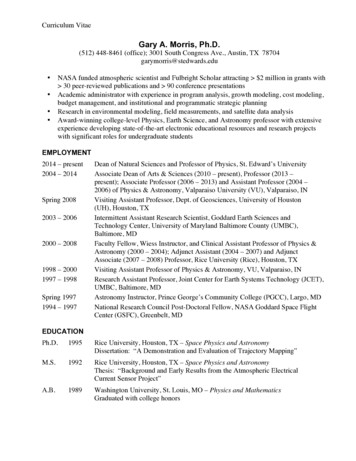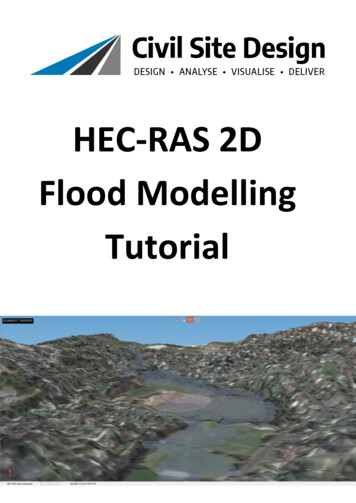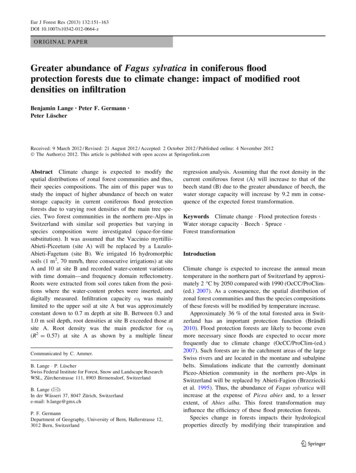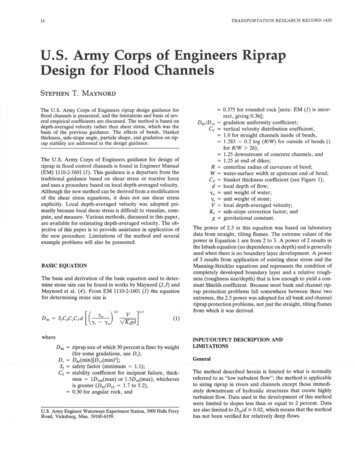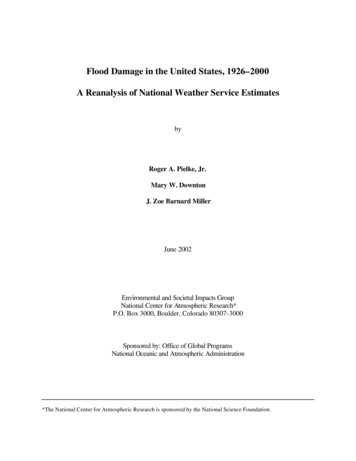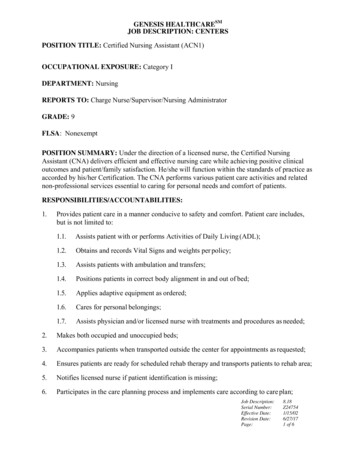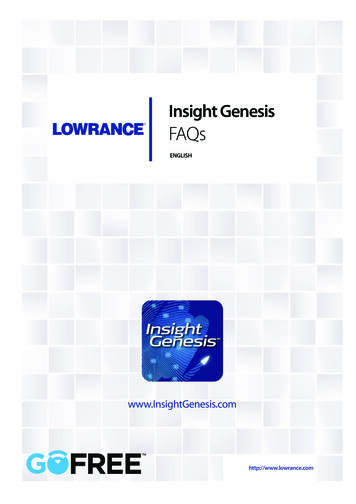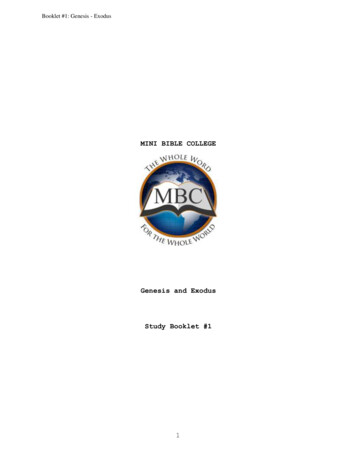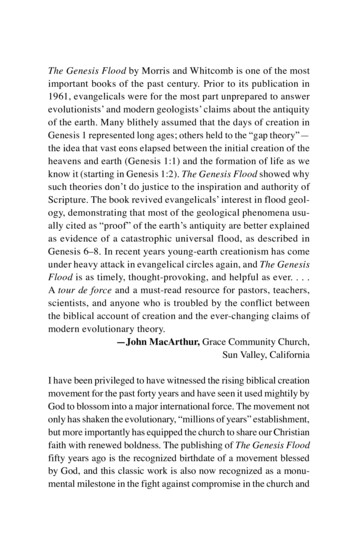
Transcription
The Genesis Flood by Morris and Whitcomb is one of the mostimportant books of the past century. Prior to its publication in1961, evangelicals were for the most part unprepared to answerevolutionists’ and modern geologists’ claims about the antiquityof the earth. Many blithely assumed that the days of creation inGenesis 1 represented long ages; others held to the “gap theory”—the idea that vast eons elapsed between the initial creation of theheavens and earth (Genesis 1:1) and the formation of life as weknow it (starting in Genesis 1:2). The Genesis Flood showed whysuch theories don’t do justice to the inspiration and authority ofScripture. The book revived evangelicals’ interest in flood geology, demonstrating that most of the geological phenomena usually cited as “proof” of the earth’s antiquity are better explainedas evidence of a catastrophic universal flood, as described inGenesis 6–8. In recent years young-earth creationism has comeunder heavy attack in evangelical circles again, and The GenesisFlood is as timely, thought-provoking, and helpful as ever. . . .A tour de force and a must-read resource for pastors, teachers,scientists, and anyone who is troubled by the conflict betweenthe biblical account of creation and the ever-changing claims ofmodern evolutionary theory.—John MacArthur, Grace Community Church,Sun Valley, CaliforniaI have been privileged to have witnessed the rising biblical creationmovement for the past forty years and have seen it used mightily byGod to blossom into a major international force. The movement notonly has shaken the evolutionary, “millions of years” establishment,but more importantly has equipped the church to share our Christianfaith with renewed boldness. The publishing of The Genesis Floodfifty years ago is the recognized birthdate of a movement blessedby God, and this classic work is also now recognized as a monumental milestone in the fight against compromise in the church and
for biblical inerrancy in general during our skeptical modern era.Finding a copy of The Genesis Flood in an Australian bookstoreand devouring its contents was a key event that led me to join themodern biblical creation movement in the 1970s. Drs. Whitcomband Morris became real “heroes of the faith” for me. I saw them asgiants in Christian apologetics.—Ken Ham, BSc (Environmental Biology), President,Answers in Genesis and The Creation MuseumWhen The Genesis Flood was published it was the combined voiceof two courageous men crying, as it were, in the wilderness. Theydared to take a stand against the pervading compromise on theissue of creation and the flood by robustly tackling head-on theuniformitarian geological assumptions that underpin the secularworldview on origins that had mesmerized so many Christiansinto compromising the opening chapters of God’s Word. Singlehandedly these men with this book kindled a fire that today is stillraging. Little did they know the global impact this book wouldhave. Like so many others I know, I read this book as a youngChristian in my teenage years when I was already a buddinggeologist, and it totally resolved my ongoing struggle to reconcilethe geology I was learning in the secular textbooks with the trueaccount of earth’s history in God’s Word. Not only did this bookconvince me that God’s Word provides the only reliable basis forunderstanding geology, but it was foundational in igniting mypassion for and calling into full-time creation ministry to upholdthe truth of God’s Word and defend it from compromise, beginning at the very first verse. This book remains a classic workthat is a must-read for those who would be informed and equipthemselves both to stand on the authority of God’s Word in everyarea of life and knowledge and to defend their Christian faith.—Andrew Snelling, BSc (Applied Geology),PhD (Geochemical Geology)
THE GENESISFLOODThe Biblical Recordand Its Scientific ImplicationsJohn C. WhitcombandHenry M. Morris
Copyright 1961 byPresbyterian and Reformed Publishing CompanyISBN-10: 0-87552-338-2ISBN-13: 978-0-87552-338-5Library of Congress CatalogCard Number: 60-13463Printed in the United States of America
ContentsLIST OF ILLUSTRATIONS AND DIAGRAMSFOREWORDPREFACE TO THE FIFTIETH ANNIVERSARY xxxvCHAPTER I. BASIC ARGUMENTS FOR A UNIVERSAL FLOODThe Depth of the Flood1The Duration of the Flood3Twenty-one Weeks of “Prevailing”4Thirty-one Weeks of “Assuaging”4The Geology of the Flood7The Size of the Ark10The Need for an Ark11The Testimony of the Apostle Peter14The Total Destruction of a Widely-Distributed Human Race16The Total Destruction of Humanity17The Extensive Distribution of the Antediluvian Race23Summary and Conclusion33CHAPTER II.BASIC ARGUMENTS AGAINST ANANTHROPOLOGICALLY UNIVERSAL FLOODIntroductionIndians in America Before the FloodThe Babylonian Flood AccountThe Presuppositions of Age Determination Methodsv36373743
List of Illustrations and DiagramsFig. 1Fig. 2Fig. 3Fig. 4Fig. 5Fig. 6Fig. 7Fig. 8Fig. 9Fig. 10Fig. 11Fig. 12Fig. 13Fig. 14Fig. 15Fig. 16Fig. 17Fig. 18Fig. 19Fig. 20Fig. 21Fig. 22Fig. 23Fig. 24Fig. 25Fig. 26Fig. 27Fig. 28Henry Morris and John WhitcombHenry and Mary Louise Morris and familyJohn and Edisene Whitcomb and familyJohn and Norma WhitcombxixxxxxixxiiThe Chronology of the FloodThe Abating of the Flood WatersPatriarchal Ages at Maturity and DeathDiagram of Three Genesis KindsGeologic Time TableGrand Canyon of the ColoradoIncised MeandersFossil GraveyardFootprints in Cretaceous River BedContemporaneous Footprints of Man and DinosaurGiant Human Footprints in Cretaceous StrataThe TuataraHeart Mountain ThrustSupposed Thrust Contact LineThe Lewis OverthrustChief MountainLewis Overthrust Contact LineIntercalation at Contact PlaneDouble Intercalation at Contact PlaneThe MatterhornMixing of Pleistocene and Cretaceous Strata“Thrust” PlaneA “Deceptive Conformity,” or ParaconformityDouble ParaconformityFlood Debris Near Los AngelesMarine TerracesBuried “Forests” in Specimen RidgeComparison of Banding 90192194199202204208210262316420426xiii
FroM tHe FirSt editionJohn C. Whitcomb, Jr., is Professor of Old Testamentat Grace Theological Seminary, Winona Lake, Indiana.His undergraduate education was completed at PrincetonUniversity where, after a two-year delay while in militaryservice, he received the A.B. degree, cum laude, in 1948.He earned the B.D. degree in 1951, the Th.M. in 1953,and the Th.D. in 1957, all at Grace Theological Seminary.Dr. Whitcomb has contributed articles to several theological journals and to The New Pictorial Bible Dictionary, The I.V.F. Bible Dictionary, and The Encyclopedia ofChristianity. He has written the commentaries on Ezra,Nehemiah and Esther in the Wycliffe Bible Commentary (Moody Press), andhis Chart of Old Testament Kings and Prophets (third edition, 1960) is beingused in scores of colleges and seminaries. Dr. Whitcomb is the author of Dariusthe Mede: A Study in Historical Identification (Eerdmans, 1959).Henry M. Morris has been Professor of HydraulicEngineering and Chairman of the Department of CivilEngineering at the Virginia Polytechnic Institute since1957. His education includes a B.S. from Rice University “with distinction,” in 1939, and the M.S. and Ph.D.degrees from the University of Minnesota, in 1948 and1950, respectively. He spent three years with the International Boundary and Water Commission, first as JuniorEngineer, then as Assistant Hydraulic Engineer, followedby four years on the civil engineering faculty at Rice. Hewas on the faculty of the University of Minnesota duringthe period 1946–1951, and was Professor and Head of the Civil EngineeringDepartment at Southwestern Louisiana University from 1951 through 1956. Afull Member of Sigma Xi, an Honor Member of Chi Epsilon, and a Memberof Phi Beta Kappa and Tau Beta Pi, all honorary societies, he is a Fellow ofthe American Society of Civil Engineers and of the American Association forAdvancement of Science, and holds professional memberships in the AmericanGeophysical Union, the American Meteorological Society, the National Societyof Professional Engineers, the Geochemical Society, the International Commission for Irrigation and Drainage Research, and others. Dr. Morris is Chairmanof the Applied Hydraulics Committee of the American Society for EngineeringEducation, is a member of various other regional and national committees, andhas biographical listings in six different “Who’s Who” publications.
ForewordIn MemoriumThe fiftieth anniversary of the publication of The Genesis Flood, coauthored by Dr. John Whitcomb and our father, Dr. Henry Morris, brings backpoignant memories. A concerted effort went into this extraordinary project,involving both focused study and diligent prayer. Looking back, it is easyto see how God blessed that effort and answered those prayers with lastingfruit. Today nearly every mailbag and every public meeting brings unsolicited testimonies from individuals who have read the book. Many say theinformation within removed roadblocks in their path to salvation or pavedthe way to spiritual growth. God used this rather technical book on scienceand theology in numerous ways, not just to catalyze the creation movement,but also to launch a new era of concern for biblical inerrancy and authority.Christian scholarship had largely retreated from the biblical creationmessage during the twentieth century. First came the theological liberalswho adapted the scientific establishment’s capitulation to natural selectionand naturalistic evolution by embracing the idea that God used evolution tocreate. Then came various attempts to allegorize the words of Genesis with“day-age” systems that lumped the stages of evolutionary development intosequential ages that God (it was assumed) adapted in His written accountto fit the cultural and scientific “ignorance” of Moses’ day.Darwin was not the first to embrace evolution by any stretch of theimagination. He was preceded by Jean-Baptiste Lamarck and Charles Lyell andby the growing popularity of “naturalism” among the social elite of Europe.Prior to those relatively recent thinkers, there were literally millennia of pantheistic and polytheistic philosophers and religionists espousing mythology ofevery stripe and description. Atheistic evolution in one form or another has beenrecorded in history from ancient Babylonian days. It is nothing new. It merelybecame “scientific” during the “enlightenment” of the Industrial Revolution.xv
xviForewordStrangely enough, it was the scientists of those days who most vehementlyopposed naturalistic thinking. Johannes Kepler and Francis Bacon in the1600s and Isaac Newton and Carolus Linnaeus in the 1700s all vigorouslyresisted the growing tendency to write God out of the design, order, andpurpose that were evident in creation.By the time of the Scopes trial in 1925, Christian scholarship had eitherembraced some form of theistic or day-age evolution, or had consignedthe ages of evolution to a “gap” between the first two verses of Genesis 1.Creation was relegated to a “secondary doctrine”—not even included in thefamous “Five Fundamentals of the Faith.” Science had become the purviewof evolutionists, and Christianity essentially retreated from the scientificarena and capitulated to the intellectual pressure of academic secularism.There were few creation resources available when our father first beganexamining the question of evolution versus the biblical account of origins,and he purposed in his heart to fill that need. Rightly discerning that thegreat Flood of Noah’s day was the cause of the rock and fossil records andthus the key to refuting evolution, he enrolled in the PhD program at theUniversity of Minnesota, taking hydraulics, hydrology, and geology. Herehe researched the power of moving water, applying scientific knowledgeto the Flood and understanding how it impacted every area of the globe.The early books of Henry Morris began chipping away at the strongholdsof evolution with the publication of That You Might Believe in 1946 andThe Bible and Modern Science in 1951, initially raising a storm of negative reaction from the “intellectuals” in the American Scientific Affiliation(ASA)—especially after a release of adapted articles in InterVarsity’s Hismagazine. Bernard Ramm published his negative critique of recent creationin his 1954 release A Christian View of Science and Scripture, effectivelywinning over “all” scientifically minded evangelicals. Very few technicallyeducated Christians seemed to be willing to accept the Bible at face value.Dr. Whitcomb grew up in a military family, trained to follow his forebearsinto military leadership. He accepted Christ as his Savior while a studentat Princeton University through the witness of a faithful Christian. Soon itbecame clear to him that the creation doctrine of Scripture was incompatible with evolution and great ages, which he had assumed must be true, andhe found solace in the gap theory. Later, at Grace Theological Seminary,he heard Henry Morris demonstrate that Scripture would not allow suchcompromise, and furthermore that science did not require it. At the time,both were writing on the subject, and soon they agreed to join their efforts.
ForewordxviiDuring the decade of the 1950s, Drs. Morris and Whitcomb fine-tunedtheir thoughts into what would become the 1961 release of The GenesisFlood. That book, in the sovereign plan of God, became the catalyst thatopened the gates to the pent-up flood of Christian professionals who, likeGod’s loyal “seven thousand” in the days of Elijah (1 Kings 19:18), had notyet bowed their knee to the Baal of evolutionary compromise. Never beforeexposed to the scientific support for Scripture, they readily accepted it whenthey saw it. And thus a revival among scientifically-trained Christians began.No other book had ever presented such a case for biblical accuracy andaut
The book revived evangelicals’ interest in flood geol-ogy, demonstrating that most of the geological phenomena usu-ally cited as “proof” of the earth’s antiquity are better explained as evidence of a catastrophic universal flood, as described in Genesis 6–8. In recent years young-earth creationism has come under heavy attack in evangelical circles again, and The Genesis Flood is as .

